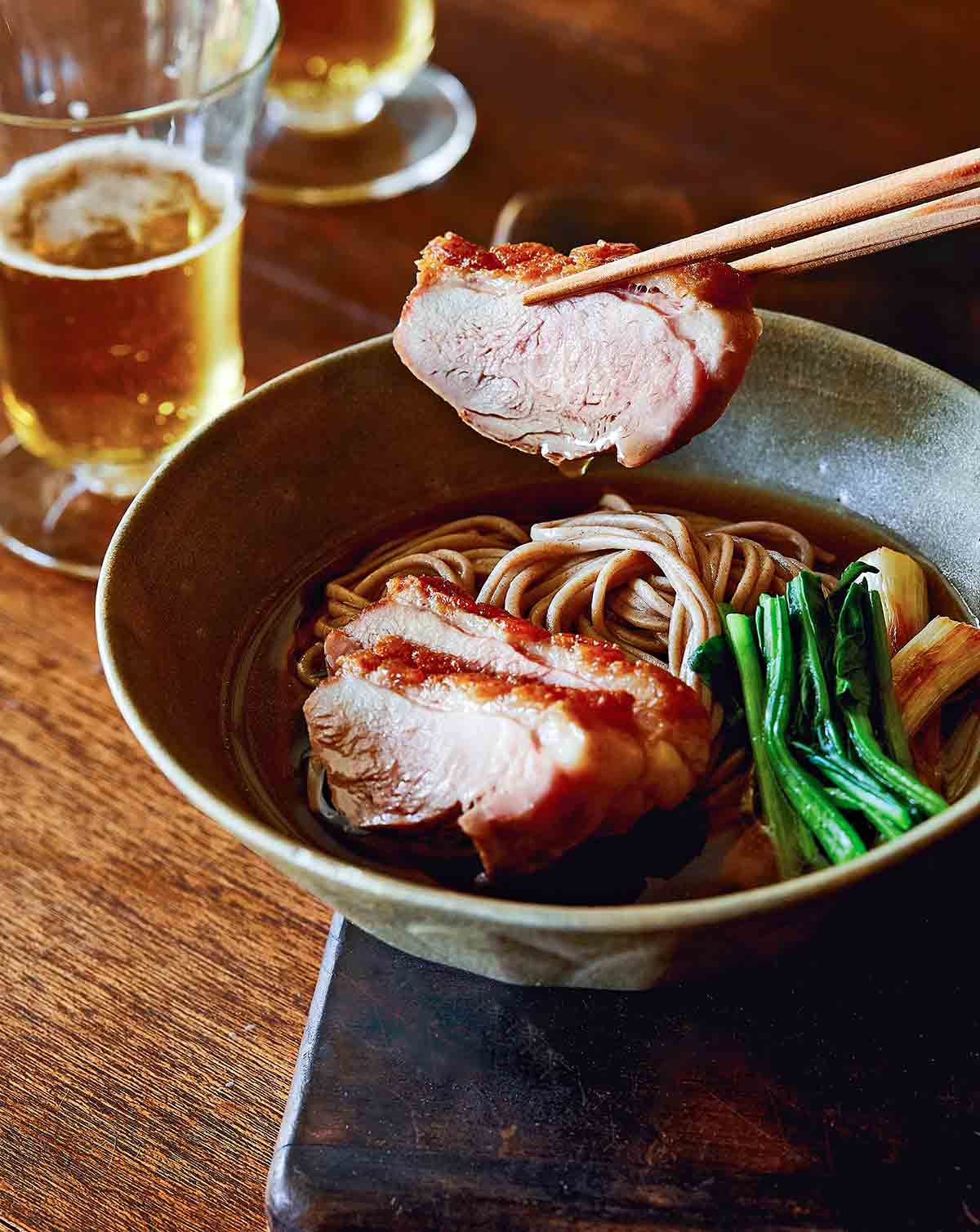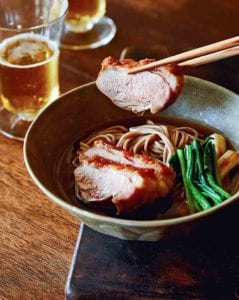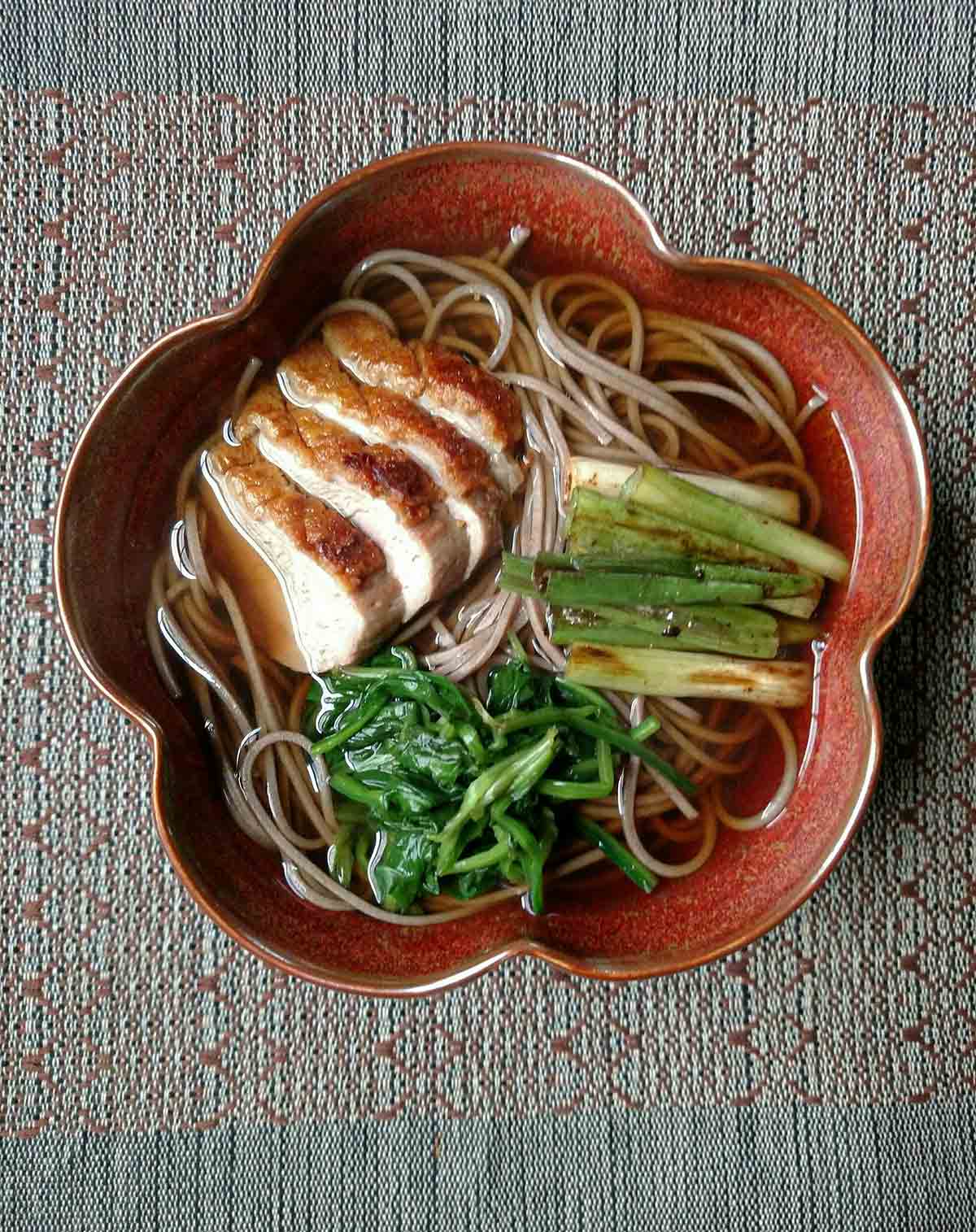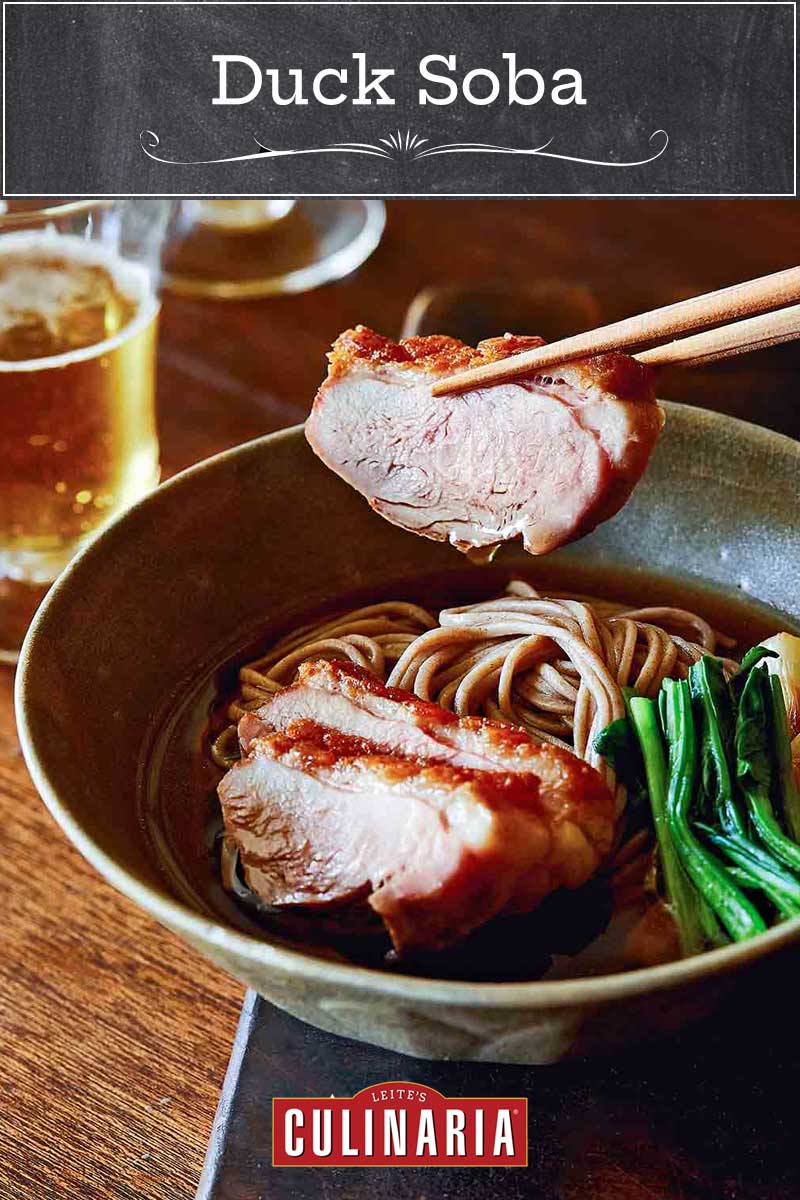
This duck soba is a slurpable bowl of soul-satisfying goodness that combines hearty soba noodles, crisp-skinned duck breast, spinach, and fried scallions in a perfectly seasoned dashi broth. We can understand why it’s revered as a New Year’s Eve tradition in Japan as we feel pretty darn lucky each time we’re fortunate enough to partake of it. (And it really is all about your perspective, isn’t it?)–Angie Zoobkoff
Want to Save This?

Duck Soba
Ingredients
For the dashi broth
- 8 cups water
- One (5-by 10-inch) sheet kombu (or enough smaller pieces to make a similar size rectangle)
- 4 cups tightly packed bonito flakes
For the seasoned spinach
- 1 pound regular or baby spinach, chopped (or other tender, leafy green)
- 1/2 cup dashi
- 2 tablespoons low-sodium or regular soy sauce
- 2 teaspoons mirin
For the soba
- 1 about 5 ounces skin-on duck breast
- Kosher salt
- 4 scallions, cut into 2-inch (5-cm) lengths
- 3 cups dashi
- 3 tablespoons plus 1 teaspoon low-sodium or regular soy sauce
- 1 tablespoon plus 1 teaspoon mirin
- 7 ounces dried soba noodles
- 1/2 cup seasoned spinach
Instructions
Make the dashi
- In a large pot over high heat, bring 8 cups water to a gentle simmer. Remove from the heat and add the kombu. Let sit for 5 minutes.
- Add the bonito flakes, cover, and let sit for 15 minutes.
- Strain the broth through a fine-mesh strainer and let cool. (You can cover and refrigerate the dashi for up to 2 days or freeze it for a couple months.)
Make the seasoned spinach
- Bring a pot of salted water to a boil. Fill a large bowl halfway with ice water.
- Add the spinach to the boiling water and cook until wilted, 1 to 2 minutes—a shorter bath for baby spinach, longer for sturdier leaves. Drain the spinach in a colander and then plunge it into the ice bath.
- When the spinach is completely cool, drain it, squeeze it with your hands to remove as much water as possible, and transfer it to a small bowl.
- Stir in the dashi, soy sauce, and mirin. Cover and refrigerate for an hour before serving.
Make the soba
- With a sharp knife, score the skin of the duck breast diagonally every 1/4 inch (6 mm), being careful not to slice all the way to the meat, then repeat in the opposite direction to create a crosshatch pattern.
- Season the duck breast on both sides with 1 teaspoon salt and let sit at room temperature for 20 minutes.
- Place a medium skillet over medium heat and add 1/4 cup water. Place the duck in the pan, skin side down, and cook until the water has completely evaporated, 6 to 10 minutes. Continue to cook until the skin is browned and crisp, 10 to 15 minutes more. Flip the duck breast so it’s skin side up and cook to your desired doneness, about 3 minutes for medium-rare or 5 minutes for medium-well. Transfer the breast to a cutting board.
- Drain the fat from the skillet and return it to medium heat. Add the scallions and cook until lightly browned and wilted, 2 to 5 minutes.
- Meanwhile, in a medium pot over high heat, bring 6 cups water to a boil and season liberally with salt.
- In a separate saucepan over high heat, combine the dashi, soy sauce, mirin, and 1 teaspoon salt and bring to a simmer.
- Cook the soba in the boiling water according to the package instructions, then drain and divide between 2 bowls.
- Thinly slice the duck on a diagonal. Ladle the broth over the soba and top with the sliced duck and browned scallions. Add a spoonful of spinach and serve immediately.

Explore More with AI
Nutrition
Nutrition information is automatically calculated, so should only be used as an approximation.
Recipe Testers’ Reviews
I slurped my share of soba in all the years I lived in Japan, certainly on many New Year’s Eves. We’re not known for duck dishes, but duck soba, called kamo nanban with charred scallions, is in fact a thing in Japan, and this version with spinach ohitashi is quite good! Gentle dashi balances out the richness of the duck and I loved the slight crunch of the scallions and spinach against the smooth soba noodles.
Do keep in mind that like noodle soups from other Asian cultures, soba is super-fast to eat, but preparing it with homemade broth is somewhat of a slow ritual. Here, I’m not going to nitpick and point out little steps that stray from the traditional method, as this recipe worked perfectly fine.
If you can’t find big sheets of kombu (I don’t think I ever have), just gather cut pieces to make roughly the same size. If you’re lucky enough to encounter different types of bonito flakes at the store, avoid fine flakes that look like they came out of the tiny holes of a grater, as those are mild and mainly used as a garnish. I used hanakatsuo, wider shavings that include the dark meat near the spine of the fish for a deeper flavor. Like chicken stock, I divvied leftover dashi into jelly jars and froze it for later use. Used kombu can be very, very thinly julienned (think shredded paper) and tossed into Salt and Sugar Pickles on LC site, and spent bonito still has enough oomph to add a little flavor to fried rice or vegetable stir-fry for an interesting twist.

I’m Japanese-American and eat toshikoshi soba every year on New Year’s Eve, so this recipe was perfect for the occasion. My family isn’t too strict in terms of keeping with traditions, so I had no problem preparing a non-traditional version of soba for the occasion.
Around New Year’s Eve, they begin to sell nama-soba (fresh soba) at the Japanese grocery stores, which I would have liked to use, but I had some regular dry soba that my mother had given me. Because the dashi and spinach ohitashi could be made ahead of time, the only time-consuming aspect of the dish when preparing the dish was cooking the duck, which I had never done before. I wanted to cook the duck medium to medium-well (since I’m pregnant) so I cooked it at a slightly higher heat than medium, which I think turned out quite well. Is it typical to use water in the beginning to cook duck?
I don’t think that I’ve ever had soba with duck before, so this was a nice twist. The soup for the soba was very lightly seasoned, which I really enjoyed and full of flavor. All and all, I think this was an excellent dish, and would’ve made my mom proud. There were no particular issues with the recipe, even though I was a little intimidated about cooking duck breast for the first time.











